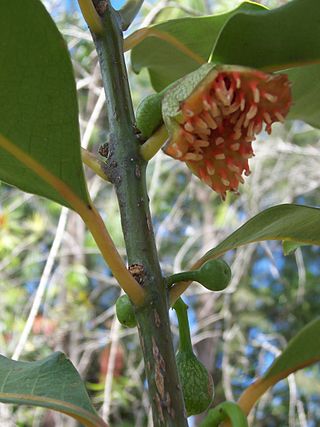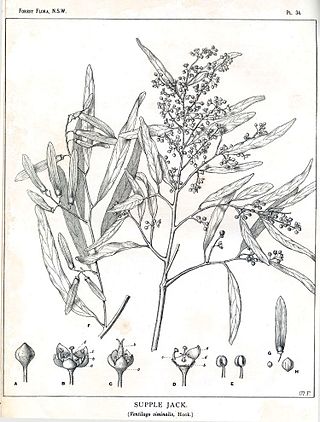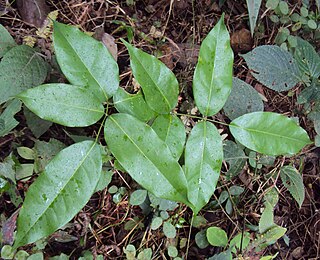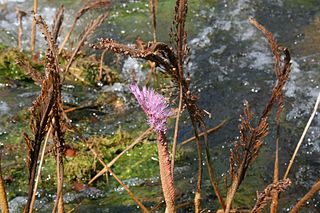
Antidesma is a genus of tropical plant in the family Phyllanthaceae formally described by Linnaeus in 1753. It is native to tropical Africa, S + E + SE Asia, Australia, and various oceanic islands. The greatest diversity occurs in Southeast Asia.

Macaranga is a large genus of Old World tropical trees of the family Euphorbiaceae and the only genus in the subtribe Macaranginae. Native to Africa, Australasia, Asia and various islands of the Indian and Pacific Oceans, the genus comprises over 300 different species. It was first described as a genus in 1806, based on specimens collected on the Island of Mauritius.

Cynometra is genus of tropical forest trees with a pantropical distribution.

Dichrostachys is an Old World genus of flowering plants in the family Fabaceae. Their Acacia-like leaves are bi-pinnately compound. Unlike Acacia their thorns are hardened branchlets rather than modified stipules. They are native from Africa to Australasia, but a centre of diversity is present in Madagascar.

Dombeya is a flowering plant genus. Traditionally included in the family Sterculiaceae, it is included in the expanded Malvaceae in the APG and most subsequent systematics. These plants are known by a number of vernacular names which sometimes, misleadingly, allude to the superficial similarity of flowering Dombeya to pears or hydrangeas. Therefore, the genus as a whole is often simply called dombeyas. The generic name commemorates Joseph Dombey (1742–1794), a French botanist and explorer in South America, involved in the notorious "Dombey affair", embroiling scientists and governments of France, Spain, and Britain for more than two years.

Dypsis is a genus of flowering plants in the family Arecaceae. They are slender, evergreen palms with yellow flowers carried in panicles amongst the pinnate leaves. Many Dypsis species have aerial branching, a rare growth habit among palms. Some have marcescent leaves that remain attached after death and trap litter for nutrients. Several species previously placed here have been returned to the restored genera Chrysalidocarpus and Vonitra.

Gaertnera is a genus of flowering plants in the family Rubiaceae. There are at least 85 species distributed across the Old World tropics from Africa to Asia.

Tambourissa is a genus of plant in family Monimiaceae. Its range includes Madagascar, the Comoro Islands, Réunion, and Mauritius. It contains the following accepted species, according to ThePlantList.org:

Ventilago is a genus of plants in the family Rhamnaceae. It includes about 40 species found in the tropics of South and SE Asia, Australasia, with one species each in Africa and Madagascar.

Dichapetalum is a genus in the plant family Dichapetalaceae. The plants are tropical lianas native mainly to tropical regions of Africa, Asia, Malesia, the West Indies, Australia and Latin America. Some species are known to be poisonous due to the presence of toxic fluorinated compounds such as fluorocarboxylic acid and dichapetalins, a unique class of cytotoxic compounds that are only found within this genus.

Rourea is a genus of plants in the family Connaraceae. They are found worldwide across the tropics and subtropics.
Erythrospermum is a genus of flowering plants belonging to the family Achariaceae.
Oubanguia is a genus of flowering plants belonging to the family Lecythidaceae.

Rhodocolea is a genus of flowering plants belonging to the family Bignoniaceae.
Microsteira is a genus of flowering plants belonging to the family Malpighiaceae.

Mourera is a genus of flowering plants belonging to the family Podostemaceae.

Pterophylla is a genus of trees of the family Cunoniaceae, with species found growing naturally in Madagascar, Malesia, Papuasia, and the Pacific Islands, formerly included in Weinmannia.

Zanthoxyloideae is a subfamily of the family Rutaceae.














